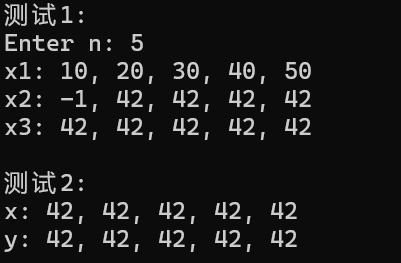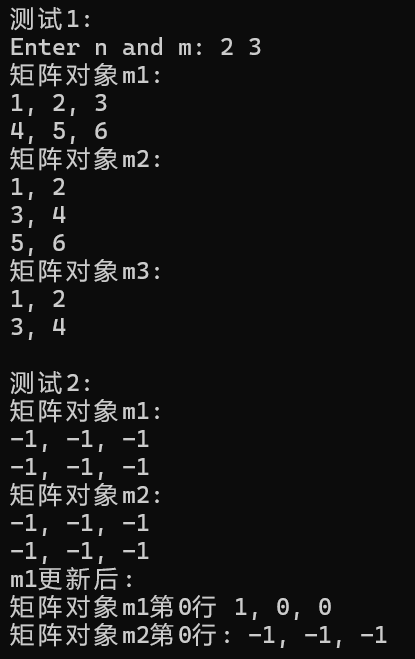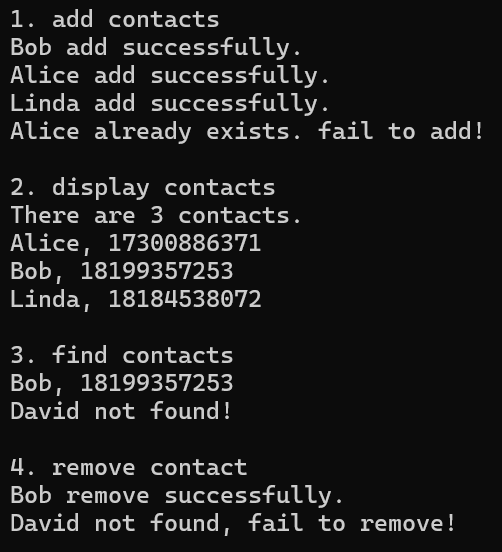##task 1
#代码
1 #pragma once 2 3 #include <iostream> 4 #include <string> 5 6 class Button { 7 public: 8 Button(const std::string &label_); 9 const std::string& get_label() const; 10 void click(); 11 12 private: 13 std::string label; 14 }; 15 16 Button::Button(const std::string &label_): label{label_} { 17 } 18 19 inline const std::string& Button::get_label() const { 20 return label; 21 } 22 23 inline void Button::click() { 24 std::cout << "Button '" << label << "' clicked\n"; 25 }
1 #include "window.hpp" 2 #include <iostream> 3 4 void test(){ 5 Window w("Demo"); 6 w.add_button("add"); 7 w.add_button("remove"); 8 w.add_button("modify"); 9 w.add_button("add"); 10 w.display(); 11 w.close(); 12 } 13 14 int main() { 15 std::cout << "用组合类模拟简单GUI:\n"; 16 test(); 17 }
1 #pragma once 2 3 #include <iostream> 4 #include <vector> 5 #include <algorithm> 6 #include "button.hpp" 7 8 // 窗口类 9 class Window{ 10 public: 11 Window(const std::string &title_); 12 void display() const; 13 void close(); 14 void add_button(const std::string &label); 15 void click_button(const std::string &label); 16 17 private: 18 bool has_button(const std::string &label) const; 19 20 private: 21 std::string title; 22 std::vector<Button> buttons; 23 }; 24 25 Window::Window(const std::string &title_): title{title_} { 26 buttons.push_back(Button("close")); 27 } 28 29 inline void Window::display() const { 30 std::string s(40, '*'); 31 std::cout << s << std::endl; 32 std::cout << "window : " << title << std::endl; 33 int cnt = 0; 34 for(const auto &button: buttons) 35 std::cout << ++cnt << ". " << button.get_label() << std::endl; 36 std::cout << s << std::endl; 37 } 38 39 inline void Window::close() { 40 std::cout << "close window '" << title << "'" << std::endl; 41 click_button("close"); 42 } 43 44 inline bool Window::has_button(const std::string &label) const { 45 for(const auto &button: buttons) 46 if(button.get_label() == label) 47 return true; 48 49 return false; 50 } 51 52 inline void Window::add_button(const std::string &label) { 53 if(has_button(label)) 54 std::cout << "button " << label << " already exists!\n"; 55 else 56 buttons.push_back(Button(label)); 57 } 58 59 inline void Window::click_button(const std::string &label) { 60 for(auto &button:buttons) 61 if(button.get_label() == label) { 62 button.click(); 63 return; 64 } 65 66 std::cout << "no button: " << label << std::endl; 67 }
#测试结果

#问题回答
1.window和button是组合关系:window拥有button的所有权 button的生命周期与window一致
2.(1)改为公有接口的优点:增加了灵活性,外部代码可以检查按钮是否存在 风险:破坏了封装性,存在误用风险
(2)应设计为public的情况:a用户需要直接调用:提供核心功能接口 b属于类的契约:如getter/setter方法 c稳定的接口:不会频繁变化的操作
应设计为private的情况:a内部实现细节:如has_button仅用于内部按钮管理 b易破坏对象状态:可能破坏对象一致性的操作 c辅助功能:仅为其他公有方法服务的工具函数 d实现细节可能变化:避免外部依赖内部实现
3.接口1:性能优势: 零拷贝:返回引用,避免字符串复制 高效:适合频繁调用场景
安全性考虑: 生命周期依赖:调用者需确保Button对象存活 修改风险:虽然返回const引用,但需注意线程安全
接口2:性能劣势: 拷贝开销:每次调用都复制整个字符串 内存分配:可能涉及动态内存分配
安全性优势: 生命周期独立:返回副本,与原始对象解耦 线程安全:副本操作不影响原始对象
4.正常运行 push_back的工作流程: a构造临时Button对象:Button(label)
b拷贝或移动临时对象到vector中
c销毁临时对象
emplace_back的工作流程:a直接在vector内存中构造Button对象
b无临时对象创建和销毁
##task2
#代码
1 #include <iostream> 2 #include <vector> 3 4 void test1(); 5 void test2(); 6 void output1(const std::vector<int> &v); 7 void output2(const std::vector<int> &v); 8 void output3(const std::vector<std::vector<int>>& v); 9 10 int main() { 11 std::cout << "深复制验证1: 标准库vector<int>\n"; 12 test1(); 13 14 std::cout << "\n深复制验证2: 标准库vector<int>嵌套使用\n"; 15 test2(); 16 } 17 18 void test1() { 19 std::vector<int> v1(5, 42); 20 const std::vector<int> v2(v1); 21 22 std::cout << "**********拷贝构造后**********\n"; 23 std::cout << "v1: "; output1(v1); 24 std::cout << "v2: "; output1(v2); 25 26 v1.at(0) = -1; 27 28 std::cout << "**********修改v1[0]后**********\n"; 29 std::cout << "v1: "; output1(v1); 30 std::cout << "v2: "; output1(v2); 31 } 32 33 void test2() { 34 std::vector<std::vector<int>> v1{{1, 2, 3}, {4, 5, 6, 7}}; 35 const std::vector<std::vector<int>> v2(v1); 36 37 std::cout << "**********拷贝构造后**********\n"; 38 std::cout << "v1: "; output3(v1); 39 std::cout << "v2: "; output3(v2); 40 41 v1.at(0).push_back(-1); 42 43 std::cout << "**********修改v1[0]后**********\n"; 44 std::cout << "v1: \n"; output3(v1); 45 std::cout << "v2: \n"; output3(v2); 46 } 47 48 // 使用xx.at()+循环输出vector<int>数据项 49 void output1(const std::vector<int> &v) { 50 if(v.size() == 0) { 51 std::cout << '\n'; 52 return; 53 } 54 55 std::cout << v.at(0); 56 for(auto i = 1; i < v.size(); ++i) 57 std::cout << ", " << v.at(i); 58 std::cout << '\n'; 59 } 60 61 // 使用迭代器+循环输出vector<int>数据项 62 void output2(const std::vector<int> &v) { 63 if(v.size() == 0) { 64 std::cout << '\n'; 65 return; 66 } 67 68 auto it = v.begin(); 69 std::cout << *it; 70 71 for(it = v.begin()+1; it != v.end(); ++it) 72 std::cout << ", " << *it; 73 std::cout << '\n'; 74 } 75 76 // 使用auto for分行输出vector<vector<int>>数据项 77 void output3(const std::vector<std::vector<int>>& v) { 78 if(v.size() == 0) { 79 std::cout << '\n'; 80 return; 81 } 82 83 for(auto &i: v) 84 output2(i); 85 }
#运行结果

#问题回答
1.含参数的构造 复制构造 5个
2. 2 2 3
3.可以 区别: 边界检查 at()会进行边界检查,如果索引越界会出现异常 性能 operator[]通常比at()更快 at()更安全
4.可以 调用size()来方法返回对象长度的int值,可以输出-1
优势:避免不必要的拷贝构造,节省内存 限制:不能通过const引用修改所引用的对象,只能进行只读操作
5.深复制 int& const int& 推断at()必须提供const重载版本
##task 3
#代码
1 #include "vectorInt.hpp" 2 #include <iostream> 3 4 void test1(); 5 void test2(); 6 void output1(const vectorInt &vi); 7 void output2(const vectorInt &vi); 8 9 int main() { 10 std::cout << "测试1: \n"; 11 test1(); 12 13 std::cout << "\n测试2: \n"; 14 test2(); 15 } 16 17 void test1() { 18 int n; 19 std::cout << "Enter n: "; 20 std::cin >> n; 21 22 vectorInt x1(n); 23 for(auto i = 0; i < n; ++i) 24 x1.at(i) = (i+1)*10; 25 std::cout << "x1: "; output1(x1); 26 27 vectorInt x2(n, 42); 28 vectorInt x3(x2); 29 x2.at(0) = -1; 30 std::cout << "x2: "; output1(x2); 31 std::cout << "x3: "; output1(x3); 32 } 33 34 void test2() { 35 const vectorInt x(5, 42); 36 vectorInt y; 37 38 y.assign(x); 39 40 std::cout << "x: "; output2(x); 41 std::cout << "y: "; output2(y); 42 } 43 44 // 使用xx.at()+循环输出vectorInt对象数据项 45 void output1(const vectorInt &vi) { 46 if(vi.size() == 0) { 47 std::cout << '\n'; 48 return; 49 } 50 51 std::cout << vi.at(0); 52 for(auto i = 1; i < vi.size(); ++i) 53 std::cout << ", " << vi.at(i); 54 std::cout << '\n'; 55 } 56 57 // 使用迭代器+循环输出vectorInt对象数据项 58 void output2(const vectorInt &vi) { 59 if(vi.size() == 0) { 60 std::cout << '\n'; 61 return; 62 } 63 64 auto it = vi.begin(); 65 std::cout << *it; 66 67 for(it = vi.begin()+1; it != vi.end(); ++it) 68 std::cout << ", " << *it; 69 std::cout << '\n'; 70 }
1 #pragma once 2 3 #include <iostream> 4 5 // 动态int数组对象类 6 class vectorInt{ 7 public: 8 vectorInt(); 9 vectorInt(int n_); 10 vectorInt(int n_, int value); 11 vectorInt(const vectorInt &vi); 12 ~vectorInt(); 13 14 int size() const; 15 int& at(int index); 16 const int& at(int index) const; 17 vectorInt& assign(const vectorInt &vi); 18 19 int* begin(); 20 int* end(); 21 const int* begin() const; 22 const int* end() const; 23 24 private: 25 int n; // 当前数据项个数 26 int *ptr; // 数据区 27 }; 28 29 vectorInt::vectorInt():n{0}, ptr{nullptr} { 30 } 31 32 vectorInt::vectorInt(int n_): n{n_}, ptr{new int[n]} { 33 } 34 35 vectorInt::vectorInt(int n_, int value): n{n_}, ptr{new int[n_]} { 36 for(auto i = 0; i < n; ++i) 37 ptr[i] = value; 38 } 39 40 vectorInt::vectorInt(const vectorInt &vi): n{vi.n}, ptr{new int[n]} { 41 for(auto i = 0; i < n; ++i) 42 ptr[i] = vi.ptr[i]; 43 } 44 45 vectorInt::~vectorInt() { 46 delete [] ptr; 47 } 48 49 int vectorInt::size() const { 50 return n; 51 } 52 53 const int& vectorInt::at(int index) const { 54 if(index < 0 || index >= n) { 55 std::cerr << "IndexError: index out of range\n"; 56 std::exit(1); 57 } 58 59 return ptr[index]; 60 } 61 62 int& vectorInt::at(int index) { 63 if(index < 0 || index >= n) { 64 std::cerr << "IndexError: index out of range\n"; 65 std::exit(1); 66 } 67 68 return ptr[index]; 69 } 70 71 vectorInt& vectorInt::assign(const vectorInt &vi) { 72 if(this == &vi) 73 return *this; 74 75 int *ptr_tmp; 76 ptr_tmp = new int[vi.n]; 77 for(int i = 0; i < vi.n; ++i) 78 ptr_tmp[i] = vi.ptr[i]; 79 80 delete[] ptr; 81 n = vi.n; 82 ptr = ptr_tmp; 83 return *this; 84 } 85 86 int* vectorInt::begin() { 87 return ptr; 88 } 89 90 int* vectorInt::end() { 91 return ptr+n; 92 } 93 94 const int* vectorInt::begin() const { 95 return ptr; 96 } 97 98 const int* vectorInt::end() const { 99 return ptr+n; 100 }
#运行结果

#问题回答
1.版本2缺少自赋值检查
2.(1)static_cast<const vectorInt*>(this)作用是将当前对象的指针从非常量转换为常量指针 转换前this类型是vectorInt* 转换后类型是const vectorInt* 目的:为了调用const版本的at()成员函数
(2)const_cast<int&>作用是移除const修饰符,使返回值可以用于修改操作 转换前this返回类型是const int& 转换后返回类型是int& 目的:满足非const接口的返回类型要求
3.v1 非const版本 可用于需要修改元素的场景 v2const版本 用于只读访问,保证数据不被修改
4.可以 fill将ptr开始的n个元素都设置为value copy 从vi.ptr复制n个元素到ptr
##task 4
#代码
1 #pragma once 2 3 #include <iostream> 4 #include <algorithm> 5 #include <cstdlib> 6 7 // 类Matrix声明 8 class Matrix { 9 public: 10 Matrix(int rows_, int cols_, double value = 0); // 构造rows_*cols_矩阵对象, 初值value 11 Matrix(int rows_, double value = 0); // 构造rows_*rows_方阵对象, 初值value 12 Matrix(const Matrix &x); // 深复制 13 ~Matrix(); 14 15 void set(const double *pvalue, int size); // 按行复制pvalue指向的数据,要求size=rows*cols,否则报错退出 16 void clear(); // 矩阵对象数据项置0 17 18 const double& at(int i, int j) const; // 返回矩阵对象索引(i,j)对应的数据项const引用(越界则报错后退出) 19 double& at(int i, int j); // 返回矩阵对象索引(i,j)对应的数据项引用(越界则报错后退出) 20 21 int rows() const; // 返回矩阵对象行数 22 int cols() const; // 返回矩阵对象列数 23 24 void print() const; // 按行打印数据 25 26 private: 27 int n_rows; // 矩阵对象内元素行数 28 int n_cols; // 矩阵对象内元素列数 29 double *ptr; // 数据区 30 }; 31 32 Matrix::Matrix(int rows_, int cols_, double value) 33 : n_rows(rows_), n_cols(cols_) { 34 ptr = new double[n_rows * n_cols]; 35 std::fill(ptr, ptr + n_rows * n_cols, value); 36 } 37 38 Matrix::Matrix(int rows_, double value){ 39 n_rows = rows_; 40 n_cols = rows_; 41 ptr = new double[n_rows * n_cols]; 42 std::fill(ptr, ptr + n_rows * n_cols, value); 43 } 44 45 Matrix::Matrix(const Matrix &x){ 46 n_cols = x.n_cols; 47 n_rows = x.n_rows; 48 ptr = new double[n_rows * n_cols]; 49 std::copy(x.ptr, x.ptr + n_rows * n_cols, ptr); 50 } 51 52 Matrix::~Matrix(){ 53 delete[] ptr; 54 } 55 56 void Matrix::set(const double *pvalue, int size){ 57 if(size != n_rows*n_cols){ 58 std::cout << "ValueError: size mismatch in Matrix::set()\n"; 59 exit(1); 60 } 61 std::copy(pvalue, pvalue + size, ptr); 62 } 63 64 void Matrix::clear(){ 65 std::fill(ptr, ptr + n_rows * n_cols, 0); 66 } 67 68 double& Matrix::at(int i, int j){ 69 if(i < 0 || i >= n_rows || j < 0 || j >= n_cols){ 70 std::cout << "IndexError: index out of range in Matrix::at()\n"; 71 exit(1); 72 } 73 return ptr[i * n_cols + j]; 74 } 75 76 const double& Matrix::at(int i, int j) const { 77 if(i < 0 || i >= n_rows || j < 0 || j >= n_cols){ 78 std::cout << "IndexError: index out of range in Matrix::at()\n"; 79 exit(1); 80 } 81 return ptr[i * n_cols + j]; 82 } 83 84 int Matrix::rows() const { 85 return n_rows; 86 } 87 88 int Matrix::cols() const { 89 return n_cols; 90 } 91 92 void Matrix::print() const { 93 for (int i = 0; i < n_rows; i++) 94 { 95 for (int j = 0; j < n_cols; j++) 96 { 97 std::cout << at(i, j); 98 if (j != n_cols - 1) 99 std::cout << ", "; 100 } 101 std::cout << '\n'; 102 } 103 104 }
1 #include <iostream> 2 #include <cstdlib> 3 #include "matrix.hpp" 4 5 void test1(); 6 void test2(); 7 void output(const Matrix &m, int row_index); 8 9 int main() { 10 std::cout << "测试1: \n"; 11 test1(); 12 13 std::cout << "\n测试2: \n"; 14 test2(); 15 } 16 17 void test1() { 18 double x[1000] = {1, 2, 3, 4, 5, 6, 7, 8, 9, 10}; 19 20 int n, m; 21 std::cout << "Enter n and m: "; 22 std::cin >> n >> m; 23 24 Matrix m1(n, m); // 创建矩阵对象m1, 大小n×m 25 m1.set(x, n*m); // 用一维数组x的值按行为矩阵m1赋值 26 27 Matrix m2(m, n); // 创建矩阵对象m2, 大小m×n 28 m2.set(x, m*n); // 用一维数组x的值按行为矩阵m1赋值 29 30 Matrix m3(n); // 创建一个n×n方阵对象 31 m3.set(x, n*n); // 用一维数组x的值按行为矩阵m3赋值 32 33 std::cout << "矩阵对象m1: \n"; m1.print(); 34 std::cout << "矩阵对象m2: \n"; m2.print(); 35 std::cout << "矩阵对象m3: \n"; m3.print(); 36 } 37 38 void test2() { 39 Matrix m1(2, 3, -1); 40 const Matrix m2(m1); 41 42 std::cout << "矩阵对象m1: \n"; m1.print(); 43 std::cout << "矩阵对象m2: \n"; m2.print(); 44 45 m1.clear(); 46 m1.at(0, 0) = 1; 47 48 std::cout << "m1更新后: \n"; 49 std::cout << "矩阵对象m1第0行 "; output(m1, 0); 50 std::cout << "矩阵对象m2第0行: "; output(m2, 0); 51 } 52 53 // 输出矩阵对象row_index行所有元素 54 void output(const Matrix &m, int row_index) { 55 if(row_index < 0 || row_index >= m.rows()) { 56 std::cerr << "IndexError: row index out of range\n"; 57 exit(1); 58 } 59 60 std::cout << m.at(row_index, 0); 61 for(int j = 1; j < m.cols(); ++j) 62 std::cout << ", " << m.at(row_index, j); 63 std::cout << '\n'; 64 }
#运行结果

##task5
#代码
1 #pragma once 2 3 #include <iostream> 4 #include <string> 5 6 // 联系人类 7 class Contact { 8 public: 9 Contact(const std::string &name_, const std::string &phone_); 10 11 const std::string &get_name() const; 12 const std::string &get_phone() const; 13 void display() const; 14 15 private: 16 std::string name; // 必填项 17 std::string phone; // 必填项 18 }; 19 20 Contact::Contact(const std::string &name_, const std::string &phone_):name{name_}, phone{phone_} { 21 } 22 23 const std::string& Contact::get_name() const { 24 return name; 25 } 26 27 const std::string& Contact::get_phone() const { 28 return phone; 29 } 30 31 void Contact::display() const { 32 std::cout << name << ", " << phone; 33 }
1 # pragma once 2 3 #include <iostream> 4 #include <string> 5 #include <vector> 6 #include <algorithm> 7 #include "contact.hpp" 8 9 // 通讯录类 10 class ContactBook { 11 public: 12 void add(const std::string &name, const std::string &phone); // 添加联系人 13 void remove(const std::string &name); // 移除联系人 14 void find(const std::string &name) const; // 查找联系人 15 void display() const; // 显示所有联系人 16 size_t size() const; 17 18 private: 19 int index(const std::string &name) const; // 返回联系人在contacts内索引,如不存在,返回-1 20 void sort(); // 按姓名字典序升序排序通讯录 21 22 private: 23 std::vector<Contact> contacts; 24 }; 25 26 void ContactBook::add(const std::string &name, const std::string &phone) { 27 if(index(name) == -1) { 28 contacts.push_back(Contact(name, phone)); 29 std::cout << name << " add successfully.\n"; 30 sort(); 31 return; 32 } 33 34 std::cout << name << " already exists. fail to add!\n"; 35 } 36 37 void ContactBook::remove(const std::string &name) { 38 int i = index(name); 39 40 if(i == -1) { 41 std::cout << name << " not found, fail to remove!\n"; 42 return; 43 } 44 45 contacts.erase(contacts.begin()+i); 46 std::cout << name << " remove successfully.\n"; 47 } 48 49 void ContactBook::find(const std::string &name) const { 50 int i = index(name); 51 52 if(i == -1) { 53 std::cout << name << " not found!\n"; 54 return; 55 } 56 57 contacts[i].display(); 58 std::cout << '\n'; 59 } 60 61 void ContactBook::display() const { 62 for(auto &c: contacts) { 63 c.display(); 64 std::cout << '\n'; 65 } 66 } 67 68 size_t ContactBook::size() const { 69 return contacts.size(); 70 } 71 72 // 待补足1:int index(const std::string &name) const;实现 73 // 返回联系人在contacts内索引; 如不存在,返回-1 74 int ContactBook::index(const std::string &name) const { 75 for(int i=0; i<contacts.size(); i++) { 76 if(contacts[i].get_name() == name) { 77 return i; 78 } 79 } 80 81 return -1; 82 } 83 84 85 // 待补足2:void ContactBook::sort();实现 86 // 按姓名字典序升序排序通讯录 87 void ContactBook::sort() { 88 std::sort(contacts.begin(), contacts.end(), 89 [](const Contact &a, const Contact &b) { 90 return a.get_name() < b.get_name(); 91 }); 92 }
1 #include "contactBook.hpp" 2 3 void test() { 4 ContactBook contactbook; 5 6 std::cout << "1. add contacts\n"; 7 contactbook.add("Bob", "18199357253"); 8 contactbook.add("Alice", "17300886371"); 9 contactbook.add("Linda", "18184538072"); 10 contactbook.add("Alice", "17300886371"); 11 12 std::cout << "\n2. display contacts\n"; 13 std::cout << "There are " << contactbook.size() << " contacts.\n"; 14 contactbook.display(); 15 16 std::cout << "\n3. find contacts\n"; 17 contactbook.find("Bob"); 18 contactbook.find("David"); 19 20 std::cout << "\n4. remove contact\n"; 21 contactbook.remove("Bob"); 22 contactbook.remove("David"); 23 } 24 25 int main() { 26 test(); 27 }
#运行结果

总结:本次实验完成的时间比较长,具体原因是对一些内部细节不够了解,需要去一步一步查阅资料,慢慢对类的实现有了一定的见解,希望可以慢慢进步。





)
)
Solon AI v3.7.2 发布)









前两个参数是什么?)

)